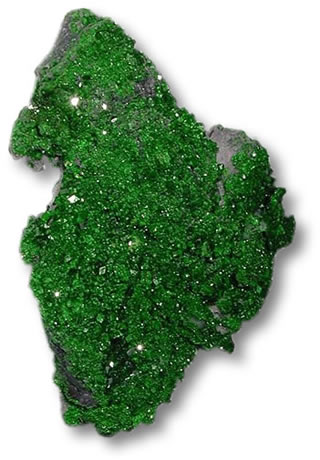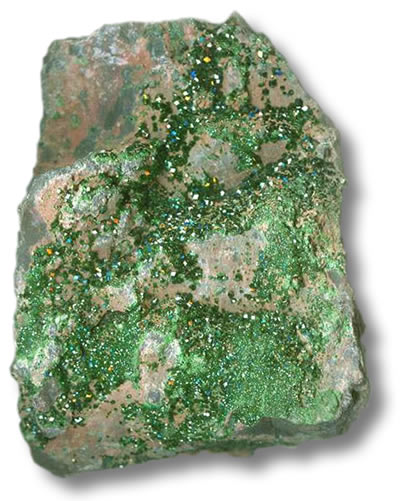Uvarovite Garnet: The Rarest Green Gem of the Garnet Family

Introduction to Uvarovite Garnet
Uvarovite garnet, renowned as the rarest member of the garnet family of gemstones, captivates collectors and gem enthusiasts with its vivid emerald-green hue and exceptional brilliance. Unlike other garnets, uvarovite is prized for its consistent green color, a result of its unique chemical composition. This gemstone, often found in small crystals or as drusy formations, is a rare find in gemstone quality, making it a treasure for those who appreciate its distinct beauty. For guidance on selecting garnets, explore the comprehensive guide to buying garnets or learn about their symbolic meanings and uses.
The Garnet Family
The garnet family is one of the most diverse in the gemstone world, encompassing a variety of species that share a common crystal structure but differ in chemical composition. The six primary garnet varieties are pyrope, almandine, spessartite, grossularite, uvarovite, and andradite. Additionally, mixed varieties, such as rhodolite (a blend of pyrope and almandine), exist. While garnets like tsavorite, a vibrant chrome-green grossularite, and demantoid, a brilliant andradite with exceptional dispersion, are rare, uvarovite stands out as the rarest of all due to its scarcity in gem-quality form. Discover more about the diversity of garnets in this detailed overview of the garnet family or explore other rare garnet varieties.
Characteristics of Uvarovite Garnet
Uvarovite is a calcium chromium silicate, distinguishing it from grossularite (calcium aluminum silicate) and andradite (calcium iron silicate). Its vibrant green color, caused by chromium, makes it the only consistently green (idiochromatic) garnet species. Uvarovite typically forms as small, opaque crystals or drusy - a coating of tiny crystals on a host rock - rather than large, transparent gems suitable for faceting.
Physical and Chemical Properties
- Composition: Calcium chromium silicate (Ca₃Cr₂(SiO₄)₃).
- Hardness: 6.5 to 7.5 on the Mohs scale, suitable for jewelry with proper care.
- Color: Vivid emerald-green, consistent across specimens.
- Transparency: Typically opaque, with rare semi-transparent crystals.
- Luster: Vitreous, contributing to its brilliant appearance.
History and Discovery
Uvarovite was first discovered in 1832 by Germain Henri Hess, a Swiss-born Russian chemist and mineralogist. He named the gem after Count Sergei Semenovitch Uvarov, a Russian statesman and amateur mineral collector who served as President of the Russian Academy of Sciences from 1818 to 1855. Hess’s contributions to mineralogy were later honored when silver telluride was named hessite after him. The discovery of uvarovite in the Ural Mountains of Russia marked it as a significant find, and its rarity has kept it a favorite among collectors ever since.
Where Uvarovite Garnets Are Found
Uvarovite garnets are exceptionally rare and are primarily sourced from the Ural Mountains in Russia, where gem-quality drusy is found. Other deposits exist in Spain, Canada, Finland, Norway, and South Africa, often associated with chromium ores, chromite, or serpentine. However, these sources typically yield opaque crystals unsuitable for gemstone use. The scarcity of transparent uvarovite makes gem-quality specimens highly coveted, with Russia remaining the primary source for drusy and rare faceted stones.
Uses and Applications
Uvarovite garnet is primarily used in jewelry, particularly as drusy pieces set in pendants, earrings, or rings, where its sparkling green crystals create a striking effect. Due to its rarity and fragility, uvarovite is rarely faceted; instead, drusy forms are popular for their natural beauty. Collectors highly value uvarovite for its vibrant color and scarcity, often displaying it in mineral collections rather than wearable jewelry. Its delicate nature requires careful setting to protect the tiny crystals in drusy formations.

Care and Maintenance
Uvarovite garnet, especially in drusy form, requires careful handling to maintain its beauty:
- Cleaning: Use lukewarm soapy water and a soft brush to gently clean uvarovite. Avoid ultrasonic cleaners or harsh chemicals, which can damage drusy crystals.
- Storage: Store uvarovite separately in a soft pouch or lined box to prevent scratches or damage to its delicate surface.
- Handling: Minimize impact or pressure, particularly for drusy pieces, as the tiny crystals can detach from the matrix.
Frequently Asked Questions About Uvarovite Garnet
What is uvarovite garnet?
Uvarovite is a rare garnet species known for its vivid emerald-green color, caused by chromium. It is typically opaque and often found as drusy, making it a collector’s gem.
Why is uvarovite considered the rarest garnet?
Uvarovite is the rarest garnet due to its scarcity in gem-quality form. Unlike other garnets, it is seldom found in large, transparent crystals suitable for faceting.
Where is uvarovite garnet found?
Uvarovite is primarily sourced from the Ural Mountains in Russia, with additional deposits in Spain, Canada, Finland, Norway, and South Africa, often in chromite or serpentine.
How should uvarovite garnet be cared for?
Clean uvarovite with lukewarm soapy water and a soft brush, store it separately to avoid scratches, and handle it gently to protect drusy crystals from damage.
What makes uvarovite garnet unique?
Uvarovite is unique for its consistent green color, caused by chromium, and its rarity. Its brilliant drusy formations and limited availability make it highly sought after.
Explore Other Garnet Varieties
- Almandine Garnet: The Deep Red Classic
- Pyrope Garnet: Rich Red Gemstone
- Rhodolite Garnet: Vibrant Purple-Red Blend
- Spessartite Garnet: Bright Orange Beauty
- Color Change Garnet: Unique Optical Marvel
- Demantoid Garnet: Brilliant Green with Dispersion
- Tsavorite Garnet: Vivid Green Gemstone
- Hessonite Garnet: Warm Cinnamon Tones
- Grossularite Garnet: Versatile Color Range
- Mali Garnet: Rare Yellow-Green Hybrid
- Star Garnet: Rare Asterism Effect

